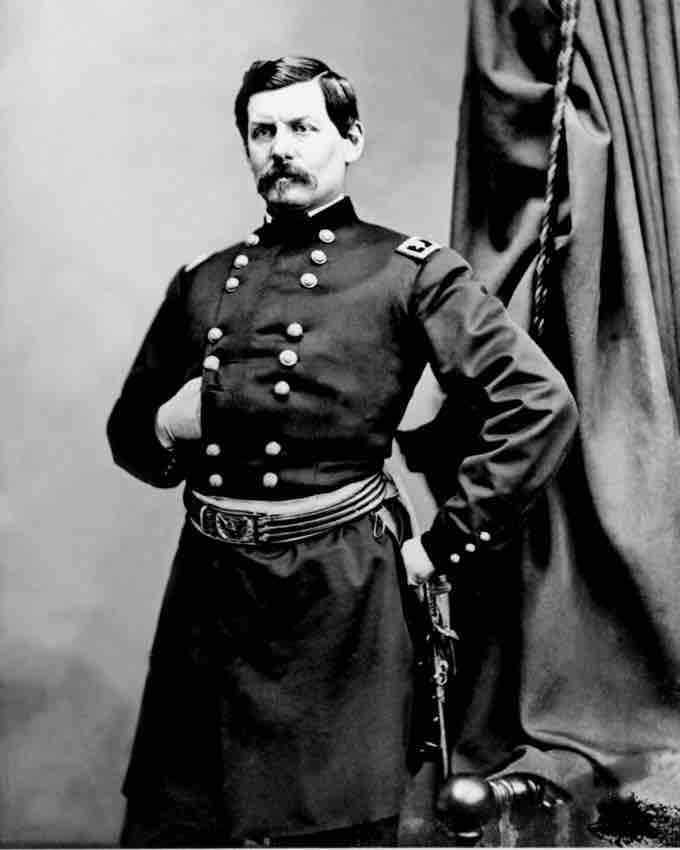The Peninsular Campaign of the American Civil War was a major Union operation launched in southeastern Virginia from March through July 1862, and was the first large-scale offensive in the eastern theater. The operation, commanded by Major General George B. McClellan, was an amphibious turning movement against the Confederate States Army in northern Virginia intended to capture the Confederate capital of Richmond. McClellan was initially successful against Confederate General Joseph E. Johnston, but the emergence of aggressive General Robert E. Lee turned the subsequent Seven Days Battles into a humiliating Union defeat.
McClellan, recently having ascended to general chief of all Union armies in addition to remaining an army commander for the Army of the Potomac, revealed on January 12, 1862, a plan to transport the Army of the Potomac by ship to Urbanna, Virginia, in order to outflank Confederate forces near Washington and capture Richmond. On January 27, President Lincoln issued orders that all armies begin offensive tactics by February 22, and four days later, he issued a supplementary decree that the Army of the Potomac specifically move to Manassas Junction and Centreville to attack Confederates there. McClellan rebutted this decision in a 22-page letter to the president, outlining his Urbanna plan. Although the president doubted the utility of the plan, he allowed McClellan to enact Urbanna and named specific officers as corps commanders to report under McClellan directly.
During this time, General Johnston moved his forces from the Washington area and assumed positions south of the Rappahannock River, thwarting the strategy underlying McClellan’s Urbanna plan. McClellan altered his plan so that his forces would land at Fort Monroe and move northwest up the Virginia Peninsula, but Congress and the press were highly critical of what was perceived as a missed opportunity to catch the Confederates in their previous positions near Washington. Another setback for the campaign was the emergence of the first Confederate ironclad ship, the CSS Virginia, which complicated further Union operations along the James River. In the subsequent Battle of Hampton Roads (March 8–9, 1862), the Virginia defeated several Union wooden ships, calling into question their usefulness in the age or the ironclad. The USS Monitor arrived on the scene the next day, leading to the world’s first clash between ironclads. Though the battle was inconclusive and neither ship was badly damaged, the clash was highly publicized around the world and did prevent the Virginia from continuing its attacks against Union wooden ships.
On March 11, President Lincoln removed McClellan from his position as general chief of the army, ostensibly so McClellan could focus on the Urbanna Plan, though later in his life McClellan would argue the decision was made to ensure the failure of his campaign. Confederate Brigadier General John B. Magruder's second defensive along the peninsula, the Warwick Line, caught McClellan by surprise. His hopes for a quick advance foiled, McClellan ordered his army to prepare for a siege of Yorktown. Just before the siege preparations were completed, the Confederates, now under the direct command of Johnston, began a withdrawal toward Richmond. The first heavy fighting of the campaign occurred in the Battle of Williamsburg, in which the Union troops managed some tactical victories, but the Confederates continued their withdrawal. An amphibious flanking movement to Eltham's Landing was ineffective in cutting off the Confederate retreat. In the Battle of Drewry's Bluff, an attempt by the U.S. Navy to reach Richmond by way of the James River was repulsed.
As McClellan's army reached the outskirts of Richmond, a minor battle occurred at Hanover Court House, and it was followed by a Confederate offense led by Johnston at the Battle of Seven Pines or Fair Oaks. The battle was inconclusive with heavy casualties, but it had lasting effects on the campaign. Johnston was wounded and replaced on June 1 by the more aggressive Robert E. Lee, who reorganized the army and prepared for offensive action in the final battles of June 25 through July 1, popularly known as the "Seven Days Battles" and considered by historians to be the second phase of the Peninsular Campaign. Though none of the battles from these seven days resulted in significant Confederate tactical victories, the fierce fighting and sudden appearance of Stonewall Jackson’s “foot cavalry” on McClellan’s western flank became unnerving for Union forces, which were eventually forced back to their base at the James River. President Lincoln eventually ordered the Army of the Potomac back to the D.C. area to support Major General John Pope’s forces in the Northern Virginia Campaign and the Second Battle of Bull Run.
Both sides suffered heavy casualties as a result of the Seven Days Battles. Even though they were victorious, many Confederates were stunned by the enormous losses they suffered. Nonetheless, Confederate morale was high following the battles, and Lee continued his aggressive strategies in the Second Battle of Bull Run and the Maryland Campaign. In turn, the Union’s morale was crushed following McClellan’s retreat and what was perceived to be poor strategic planning on the part of Union army leadership.

General George B. McClellan
General McClellan launched an invasion of Virginia, intending to take the Confederate capital of Richmond and bring an early end to the Civil War. The invasion failed, partly on account of McClellan's shortcomings, including credulity, passivity, and excessive caution.